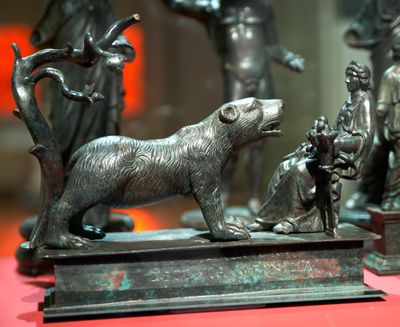「アルティオ」の版間の差分
(→関連項目) |
|||
| (同じ利用者による、間の5版が非表示) | |||
| 9行目: | 9行目: | ||
その他、ダウン(CIL 13, 4203)、ヴァイラーバッハ(CIL 13, 4113)、ヘーデルンハイム(CIL 13, 7375 [4, p 125])、シュトックシュタット(CIL 13, 11789)でも女神の碑文が発見された<ref>''CIL'' XIII</ref>。 | その他、ダウン(CIL 13, 4203)、ヴァイラーバッハ(CIL 13, 4113)、ヘーデルンハイム(CIL 13, 7375 [4, p 125])、シュトックシュタット(CIL 13, 11789)でも女神の碑文が発見された<ref>''CIL'' XIII</ref>。 | ||
| + | |||
| + | == 関連項目 == | ||
| + | * [[アンダルタ]]:ガリアのケルト神話。おおぐま座の女神か。 | ||
| + | * [[マリヤ]]:ヒッタイト神話の女神。アルティオと類似した女神か。 | ||
== 参考文献 == | == 参考文献 == | ||
| − | + | * Wikipedia:[https://en.wikipedia.org/wiki/Artio Artio](最終閲覧日:22-11-21) | |
| − | * '' | + | ** ''Corpus Inscriptionum Latinarum (CIL) vol XIII, Inscriptiones trium Galliarum et Germaniarum'' |
| − | * | + | ** Delamarre Xavier, Dictionnaire de la langue gauloise: Une approche linguistique du vieux-celtique continental, 2003, Errance, isbn:9782877723695, Xavier Delamarre |
| − | * Deyts, Simone (1992) ''Images des Dieux de la Gaule''. Paris: Editions Errance. | + | ** Deyts, Simone (1992) ''Images des Dieux de la Gaule''. Paris: Editions Errance. ISBN:2-87772-067-5. |
| − | * Green, Miranda (1992) ''Animals in Celtic Life and Myth''. London: Routledge. | + | ** Green, Miranda (1992) ''Animals in Celtic Life and Myth''. London: Routledge. ISBN:0-415-18588-2 |
| − | * | + | ** Matasović Ranko, Etymological Dictionary of Proto-Celtic, 2009, Brill, isbn:9789004173361, Ranko Matasović |
| − | * Wightman, E. M. (1970) ''Roman Trier and the Treveri'' London: Hart-Davis. | + | ** Wightman, E. M. (1970) ''Roman Trier and the Treveri'' London: Hart-Davis. ISBN:0-246-63980-6 |
| − | |||
== 私的注釈 == | == 私的注釈 == | ||
| 25行目: | 28行目: | ||
== 参照 == | == 参照 == | ||
| + | {{DEFAULTSORT:あるていお}} | ||
[[Category:ガリア神話]] | [[Category:ガリア神話]] | ||
[[Category:ケルト神話]] | [[Category:ケルト神話]] | ||
[[Category:熊]] | [[Category:熊]] | ||
| + | [[Category:黄金の林檎]] | ||
2022年11月27日 (日) 17:20時点における最新版
アルティオ(Artio、ガロ・ローマ宗教ではDea Artio)はケルトの熊の女神である。特にスイスのベルンでは、彼女の崇拝の証が発見されている。彼女の名前は、ガリア語で「熊」を意味するartosに由来する[1]。
名前[編集]
アルティオ(Artiō)はケルト語で「熊」を意味するartos (cf. 古アイルランド語art, 中期ウェールズ語arth, 古ブルトン語ard) に由来し、原インド-ヨーロッパ語 *h₂ŕ̥tḱos (「熊」) から来ている。*Arto-rix(「熊王」)として再構築されたケルト語の形態は、ラテン語化した形態*Artori(u)sを介して、Arthurの名前の源である可能性がある。バスク語のhartz(「熊」)もケルト語の借用語であると推定される[2][3]。
概要[編集]
スイスのベルン近郊で発見されたムリ像群のブロンズ像には、椅子に座った女性と向かい合う大きな熊と、熊の背後にある小さな木が描かれている。女性は膝の上に果物を乗せているようで、熊に餌を与えているようだ[4][私注 1]。この彫刻は大きな長方形のブロンズの台座に、"Deae Artioni / Licinia Sabinilla"(「女神アルティオに」または「アルティオニス」、「リシニア・サビニラから」)の銘がある。名前がガリア語でも構文がラテン語の場合、dative Artioni とすると、i-stem nominative *Artionis か n-stem nominative *Artioが与えられることになる。それはおそらく、ガリアのn-stemの主格*Artiuに対応するものだろう。
その他、ダウン(CIL 13, 4203)、ヴァイラーバッハ(CIL 13, 4113)、ヘーデルンハイム(CIL 13, 7375 [4, p 125])、シュトックシュタット(CIL 13, 11789)でも女神の碑文が発見された[5]。
関連項目[編集]
参考文献[編集]
- Wikipedia:Artio(最終閲覧日:22-11-21)
- Corpus Inscriptionum Latinarum (CIL) vol XIII, Inscriptiones trium Galliarum et Germaniarum
- Delamarre Xavier, Dictionnaire de la langue gauloise: Une approche linguistique du vieux-celtique continental, 2003, Errance, isbn:9782877723695, Xavier Delamarre
- Deyts, Simone (1992) Images des Dieux de la Gaule. Paris: Editions Errance. ISBN:2-87772-067-5.
- Green, Miranda (1992) Animals in Celtic Life and Myth. London: Routledge. ISBN:0-415-18588-2
- Matasović Ranko, Etymological Dictionary of Proto-Celtic, 2009, Brill, isbn:9789004173361, Ranko Matasović
- Wightman, E. M. (1970) Roman Trier and the Treveri London: Hart-Davis. ISBN:0-246-63980-6
私的注釈[編集]
- ↑ これは熊が世界のトーテムである、という図であると考える。
